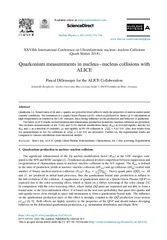Quarkonium measurements in nucleus–nucleus collisions with ALICE
Dillenseger, Pascal; Acharya, Shreyasi; Acosta, Fernando T.; Adamová, Dagmar; Adolfsson, Jonatan; Aggarwal, Madan M.; Aglieri Rinella, Gianluca; Agnello, Michelangelo; Agrawal, Neelima; Ahammed, Zubayer; Alme, Johan; Altenkaemper, Lucas; Djuvsland, Øystein; Ersdal, Magnus Rentsch; Fionda, Fiorella Maria Celeste; Nystrand, Joakim; Rehman, Attiq Ur; Røhrich, Dieter; Tambave, Ganesh Jagannath; Ullaland, Kjetil; Wagner, Boris; Zhou, Zhuo; Arsene, Ionut Cristian; Bätzing, Paul Christoph; Dordic, Olja; Lardeux, Antoine Xavier; Lindal, Svein; Mahmood, Sohail Musa; Malik, Qasim Waheed; Richter, Matthias; Røed, Ketil; Skaali, Toralf Bernhard; Tveter, Trine Spedstad; Wikne, Jon Christopher; Zhao, Chengxin; Hetland, Kristin Fanebust; Kileng, Bjarte; Nesbø, Simon Voigt; Storetvedt, Maksim Melnik; Helstrup, Håvard; Langøy, Rune; Lien, Jørgen André; Ahn, Sang Un; Aiola, Salvatore; Akindinov, Alexander; Al-Turany, Mohammad; Alam, Sk Noor; Albuquerque, D. S. D.; Aleksandrov, Dmitry; Alessandro, Bruno; ALICE, Collaboration
Peer reviewed, Journal article
Published version

Åpne
Permanent lenke
https://hdl.handle.net/1956/23491Utgivelsesdato
2019Metadata
Vis full innførselSamlinger
Originalversjon
https://doi.org/10.1016/j.nuclphysa.2018.09.024Sammendrag
Quarkonia, i.e. bound states of bb¯ and cc¯ quarks, are powerful observables to study the properties of nuclear matter under extreme conditions. The formation of a Quark-Gluon Plasma (QGP), which is predicted by lattice QCD calculations at high temperatures as reached at the LHC energies, has a strong influence on the production and behavior of quarkonia. The latest ALICE results on bottomonium and charmonium production in nucleus−nucleus collisions are presented. This includes measurements of the Υ(1S) and Υ(2S) nuclear modification factor (RAA) at forward rapidity and the J/ψ RAA and v2 as a function of centrality, pT and rapidity in Pb−Pb collisions at √sNN = 5.02 TeV. Also, first results from J/ψ measurements in Xe−Xe collisions at √sNN = 5.44 TeV are presented. Further on, the experimental results are compared to various calculations from theoretical models.
